Eggless Vanilla Cake
This single layer Eggless Vanilla Cake is super moist, light, and a one-bowl wonder. Perfect for morning tea, made without eggs and paired with a creamy vanilla buttercream.
Baking cakes without eggs is easy! Discover exactly how to make egg-free cakes in my complete guide, perfect for all your eggless baking needs!

Eggless Vanilla Cake Recipe
The Eggless Banana Cake has garnered significant acclaim, establishing itself as one of my most popular cake recipes.
Building on that success, I’m pleased to introduce it’s sophisticated counterpart.
This Eggless Vanilla Cake is its delightful cousin inspired by the original banana sensation.
Promising you a seriously moist and fluffy crumb without eggs, infused with the perfect amount of vanilla.
Consider it an egg-free version of my Basic One Layer Vanilla Cake!
With the convenience of making it in one bowl, this vanilla cake is easy to make without eggs.
You may like to try my Vegan Vanilla Cake for a complete dairy-free option too.

Why You Will Love This Recipe
- Perfect for beginner bakers.
- Vanilla cake made without eggs.
- Moist and light.
- One bowl wonder.
- Crowd-pleaser.
You’ll be pleasantly surprised by how moist this vanilla cake is, even though there are no eggs in the recipe.
The combination of Greek yogurt, olive oil and full-fat milk guarantees a moist texture.
You’ll love how yogurt and oil work together in my orange poppy seed cake too, a soft and tender crumb is guaranteed!
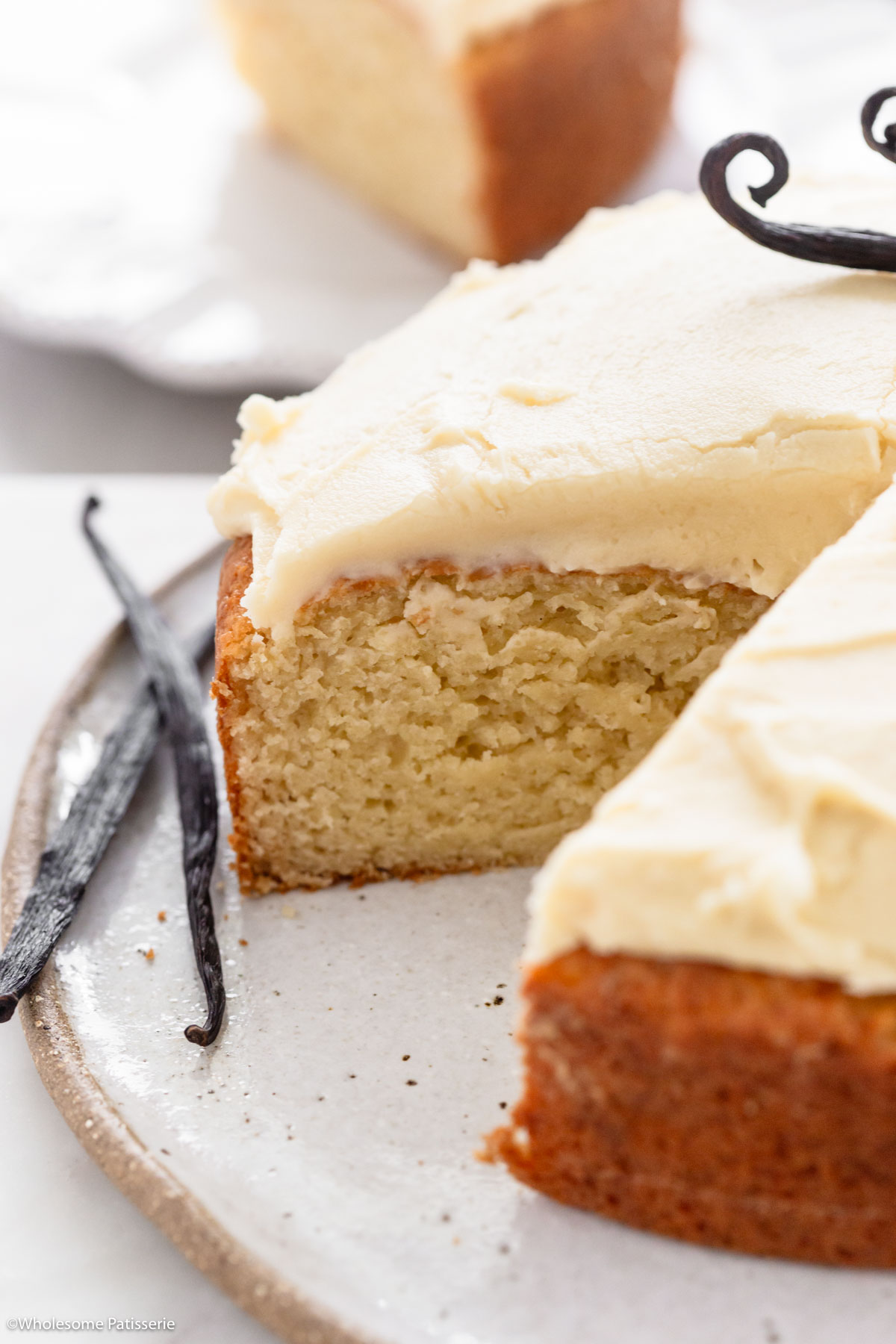
To make the batter work without eggs, we pair apple cider vinegar and baking soda to mimic the role of eggs.
It produces extra bubbles to allow the cake to rise, without leaving behind any flavor of vinegar.
So if you’re wondering if a cake can rise without eggs, the answer is YES! 🙂
It’s then paired with a quick vanilla buttercream frosting made with 4 ingredients.
Or you can add any type of frosting, such as a chocolate frosting or lemon frosting!
Adding rainbow sprinkles can be a fun twist for a birthday celebration too.
You can see sprinkles included in these cream cheese frosted brownies!
Ingredient Notes & Substitutions
A comprehensive recipe card featuring all the ingredients can be found at the end of this post.
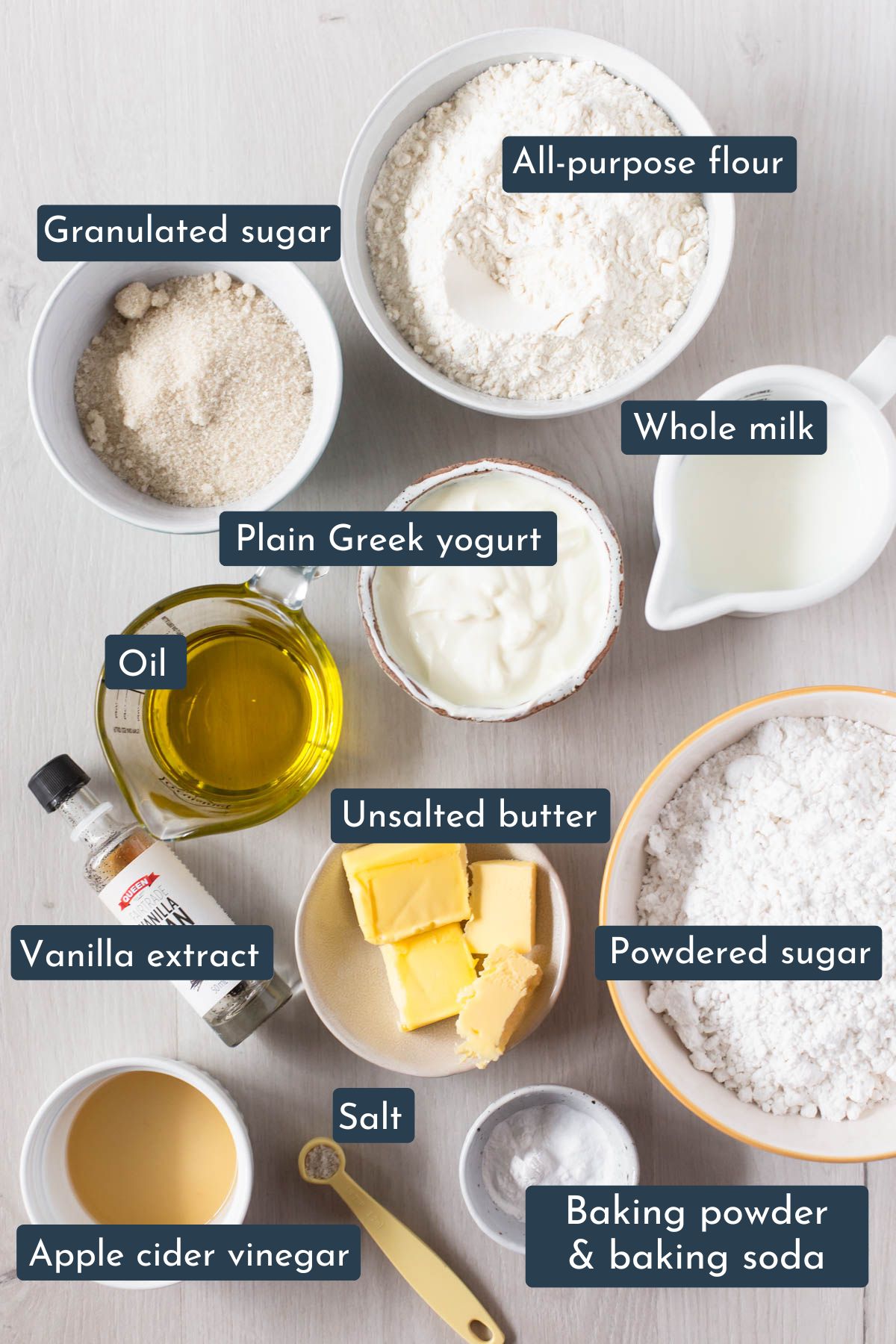
- All-purpose flour: Also known as plain flour in Australia. Make sure to accurately measure your flour for the best results.
- Baking powder and baking soda: Ensure these are not expired. To test if they still work, use this handy tip.
- Salt: Any fine salt will do.
- Granulated sugar: I used golden/raw granulated sugar for its added flavor. You can substitute it with regular white granulated sugar.
- Whole milk: Full-fat milk produces the best and most moist results. Can be substituted with low-fat milk or a dairy-free milk such as almond milk.
- Greek Yogurt: Use plain, whole milk full-fat Greek yogurt. This helps to produce a super moist and tender cake crumb.
- Olive oil: Extra virgin olive oil works best. Alternatively, use neutral-flavored vegetable oil as a substitute.
- Apple cider vinegar: This works with the leaveners to help give lift to the cake without the use of eggs. Try substituting it with white vinegar, keep in mind I have not tested this recipe using white vinegar.
- Vanilla extract: Can be substituted with two and a half teaspoons of vanilla paste.
- Unsalted butter: Use block butter. Can be substituted with salted butter, which will give your buttercream a hint of salt!
- Powdered sugar: Is also known as icing sugar and confectioners sugar.
Step By Step Instructions (with photos)
There is a full and detailed recipe card at the bottom of this post.
Step one: Preheat oven to 180ºC (356ºF). Line a round 9-inch baking pan with parchment paper, and set aside.
Got a non-stick pan? Just grease with butter, line the base with parchment paper and dust the sides with flour.
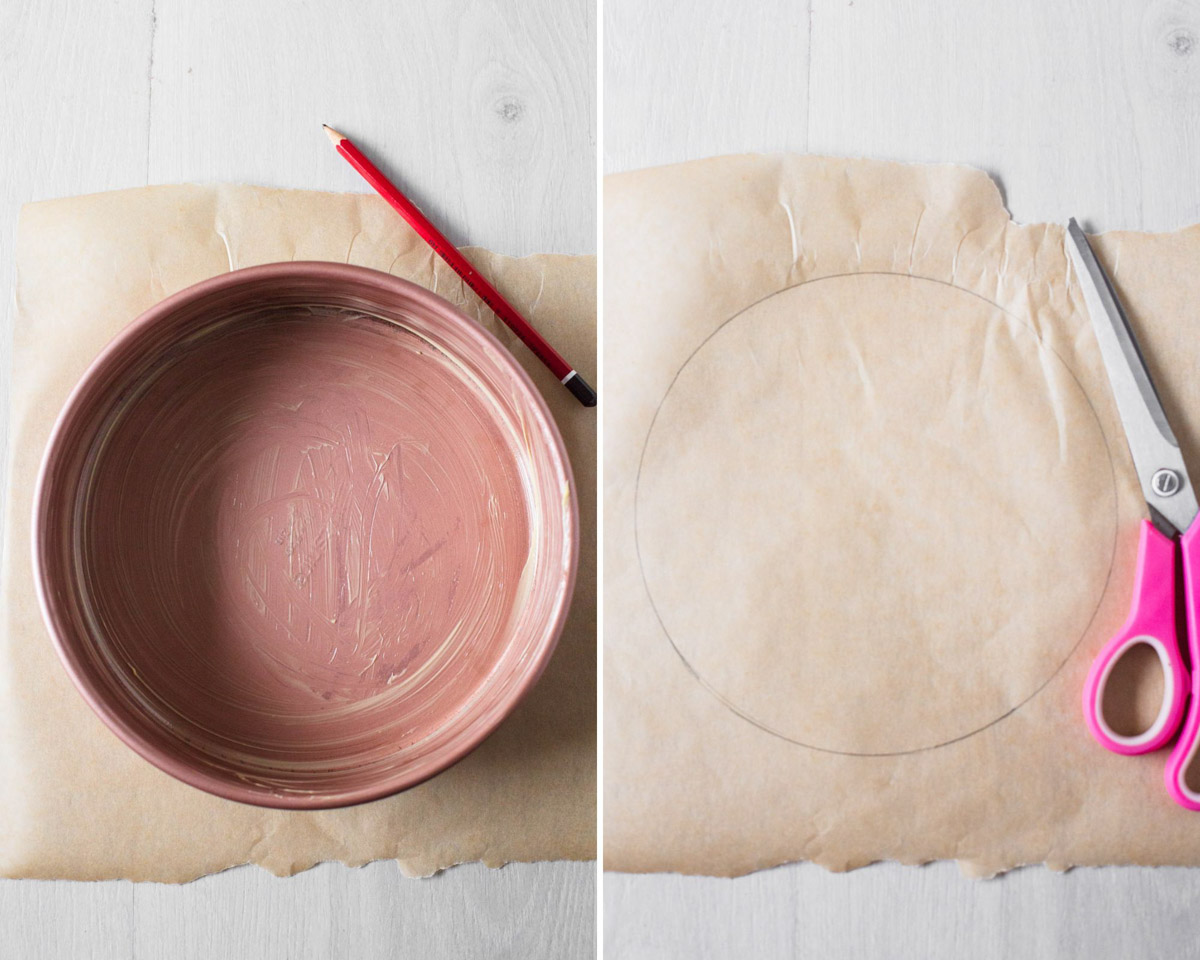
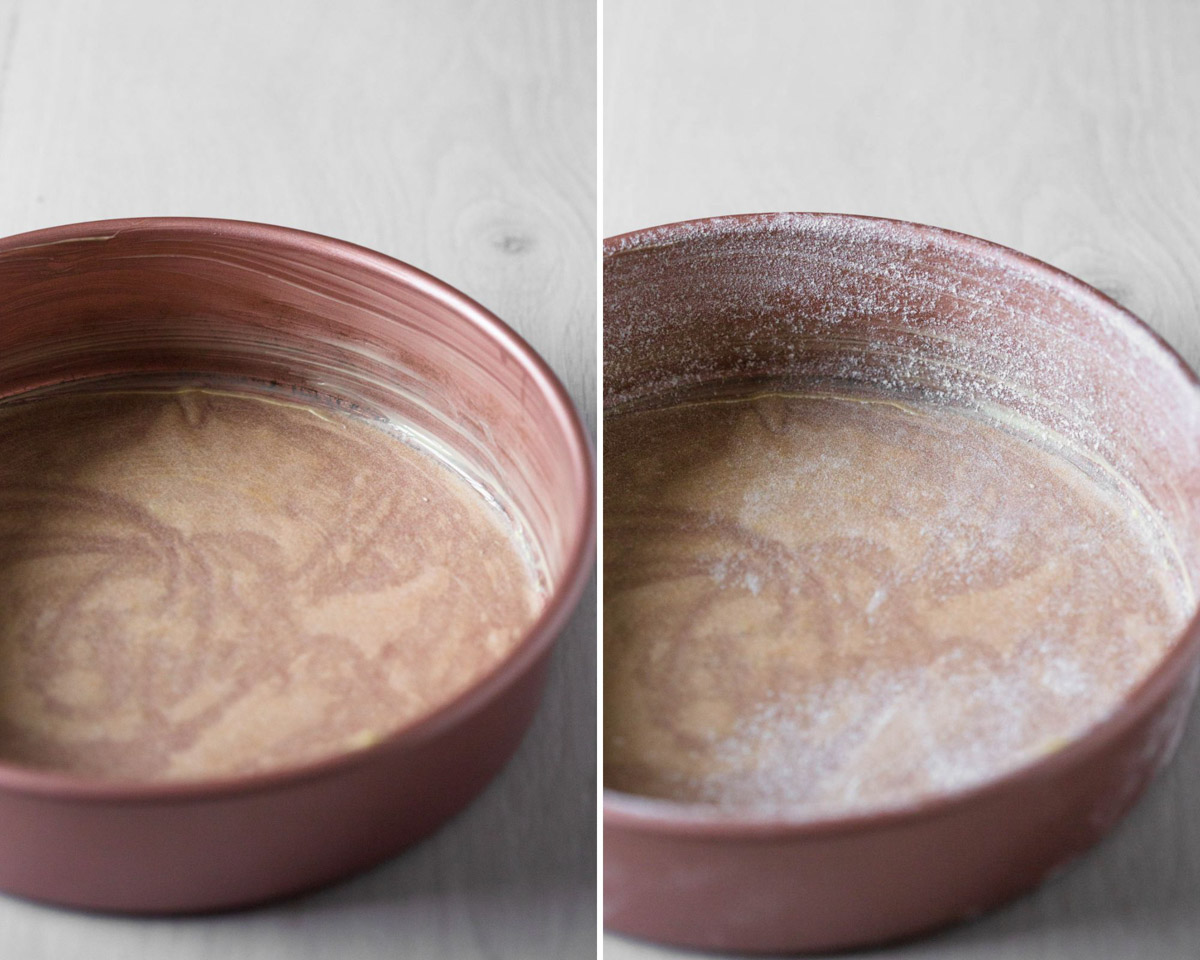
Step two: In a large mixing bowl, add flour, baking powder, baking soda and salt. Whisk until well combined.
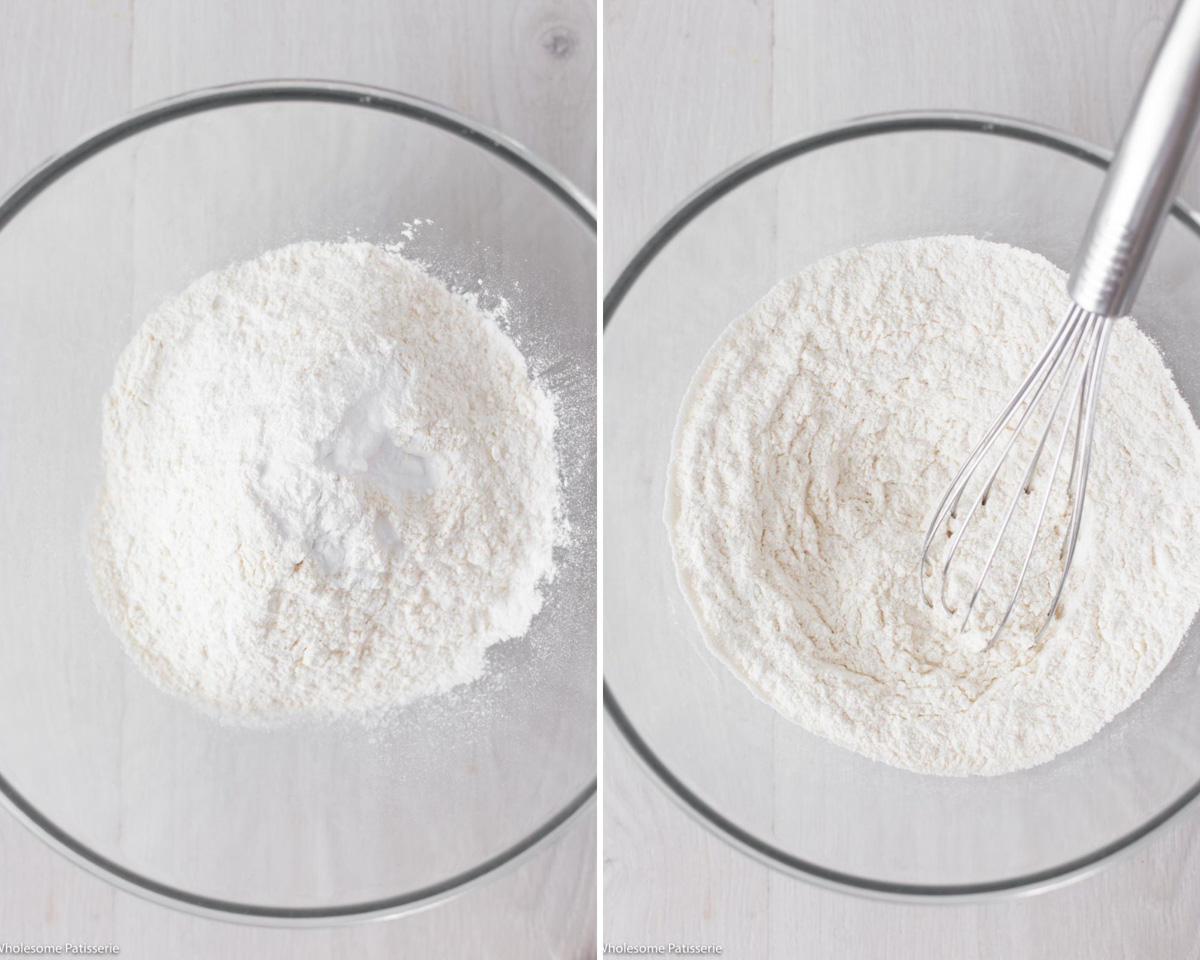
Step three: Whisk through the sugar.
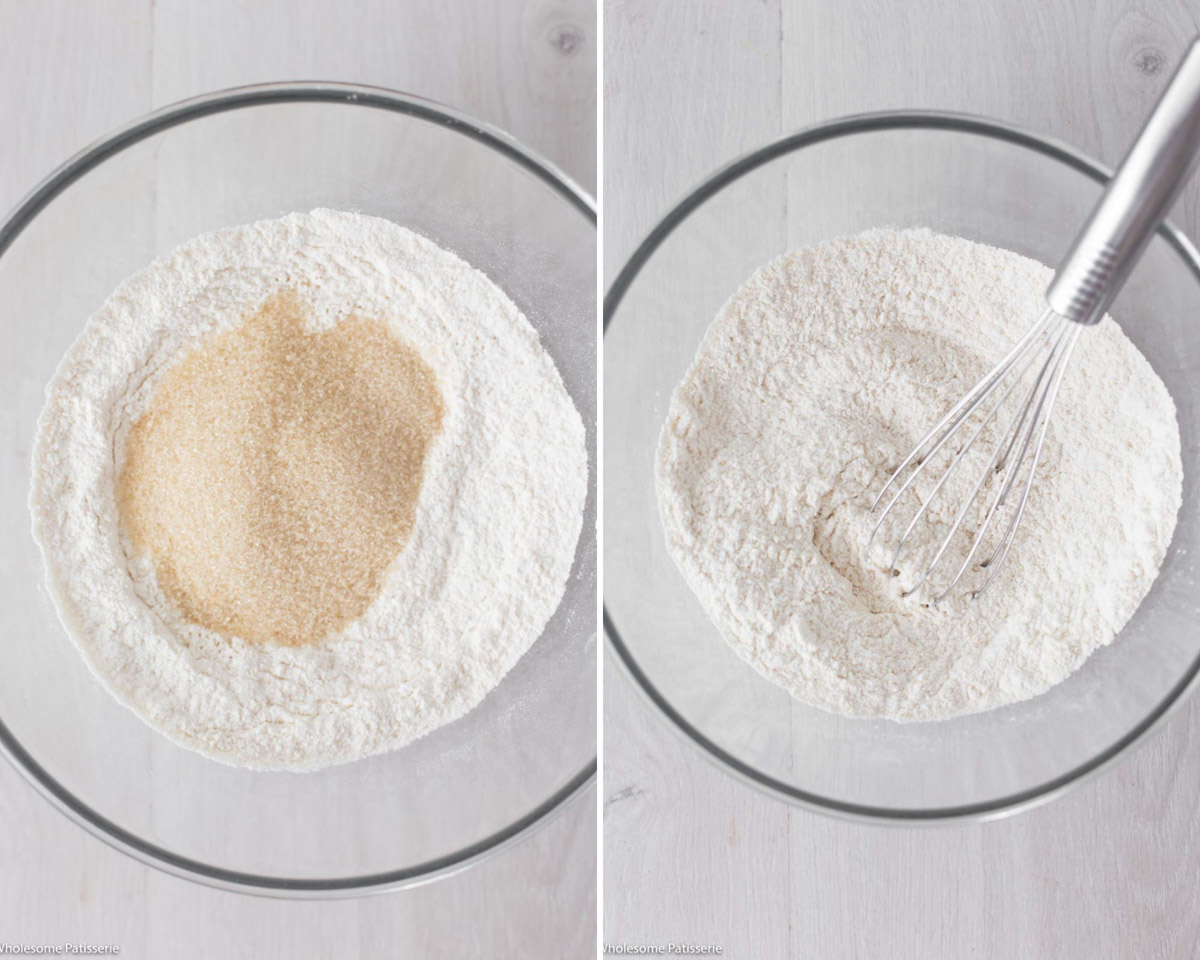
Step four: Pour in the milk, yogurt, oil, vinegar, and vanilla. Gently fold and mix with a rubber spatula until incorporated, about 40 seconds.
Ensuring not to over-mix, just until it’s incorporated into a smooth batter and no lumps/streaks of flour remain.

Step five: Pour batter into the prepared baking tin. Smoothing out the top.
Step six: Bake for 35-40 minutes, or until a toothpick inserted into the middle comes out clean and it’s golden on top.
Remove from the oven and allow cake to cool in its tin for 15 minutes.
Carefully remove from tin and transfer to a wire rack to cool completely.

Step seven: To make the frosting, in a large mixing bowl, using either electric hand beaters or a stand mixer with the paddle attached, add softened butter to the bowl.
Beat butter for a about 10 seconds to break it up and it begins to turn creamy.
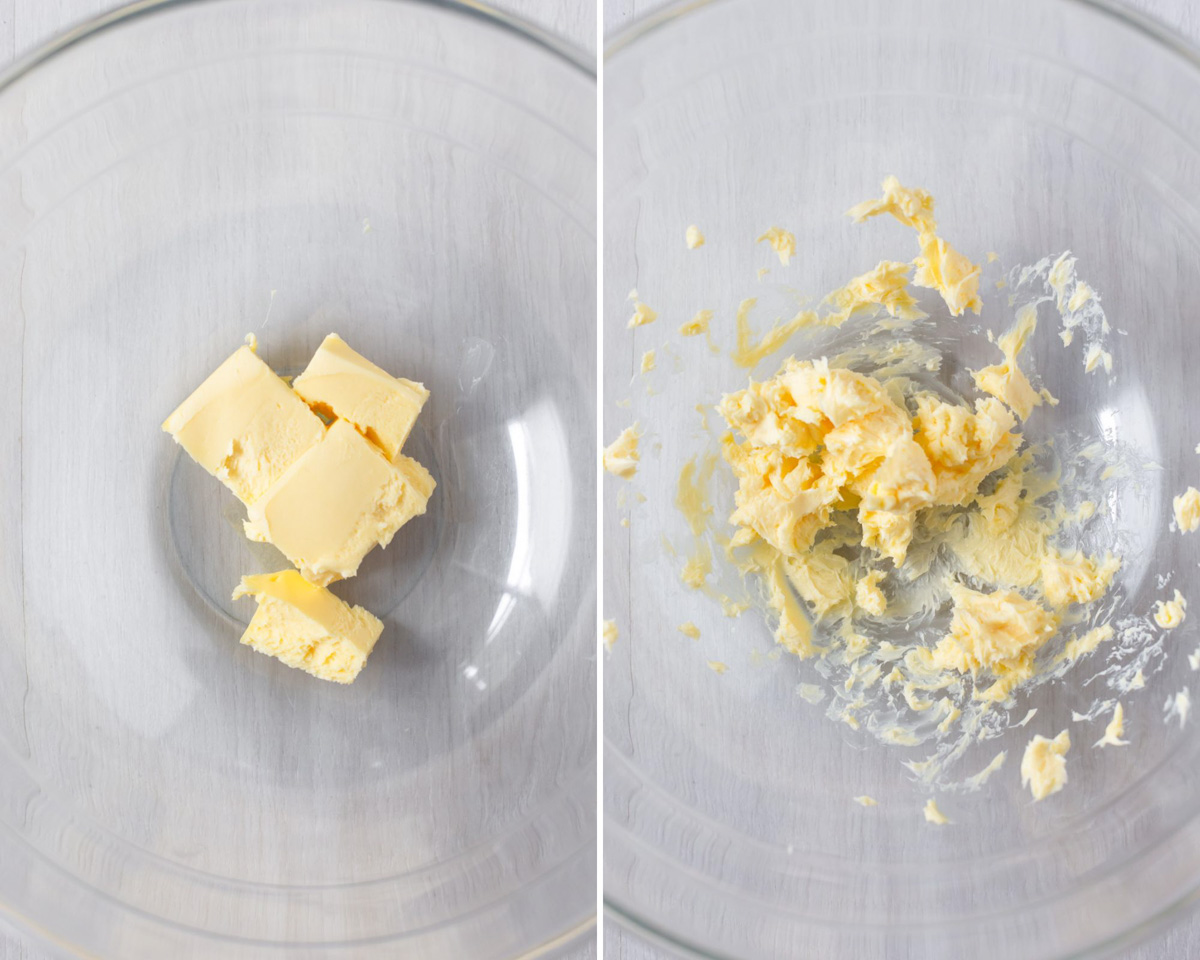
Step eight: Add icing sugar, milk and vanilla. Beat until well combined, creamy and fluffy, about 30 seconds. Scraping down the sides as needed.
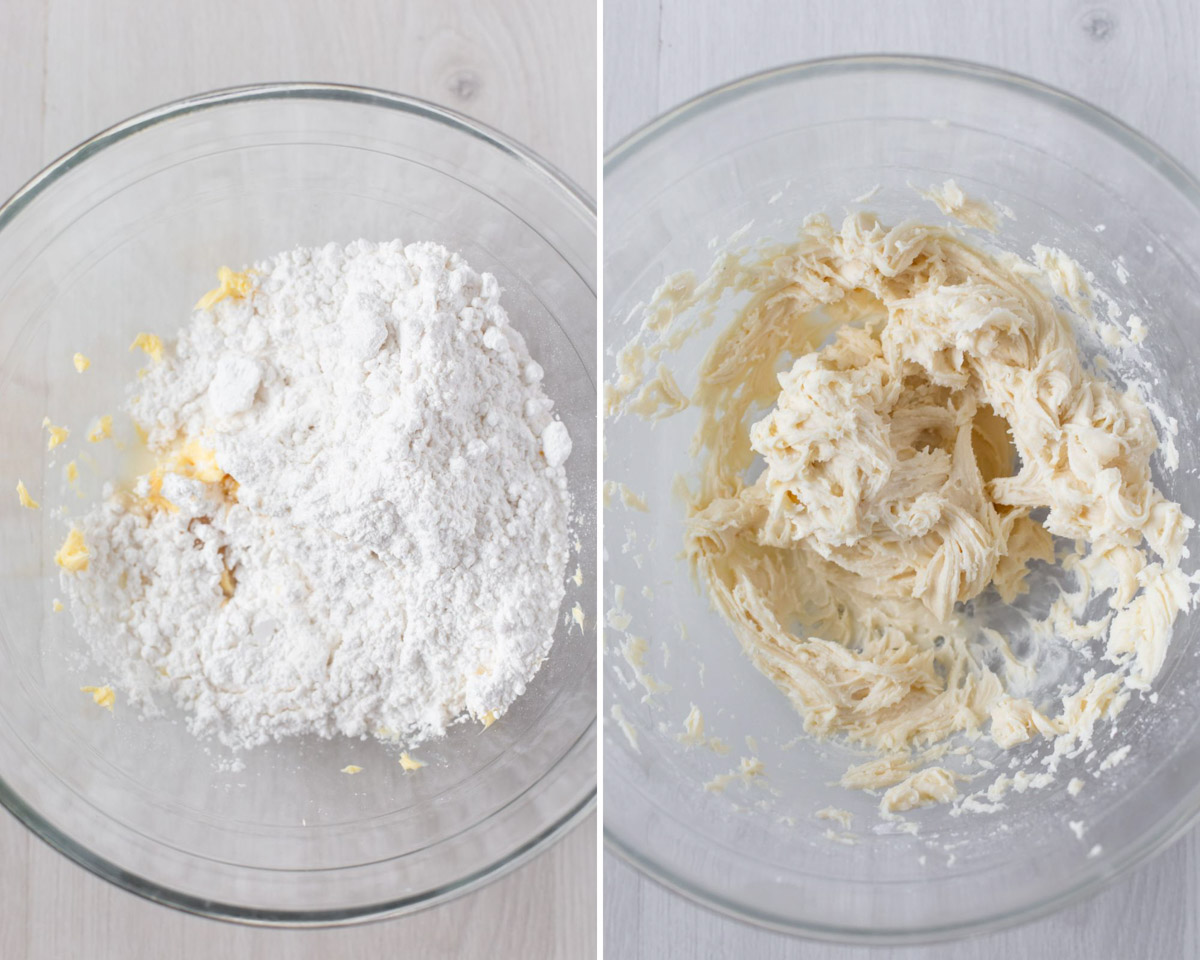
Step nine: Spread frosting over cooled cake. Set aside for the buttercream to set, about 20 minutes.
Slice into triangles and enjoy!

Expert Tips
- Measure your baking ingredients accurately: Check out my helpful guide on how to measure basic ingredients.
- Use a non-stick baking tin: For a smooth-sided cake, grease the tin with butter, line the base with parchment paper, dust the sides with flour and tap out the excess.
- Baking powder & soda: Double-check those expiry dates on your baking powder and soda! They team up with apple cider vinegar to replace eggs, so they’ve got to be fresh.
- Do not over-mix the cake batter: It will result in a tough and dense textured cake after baking.
- How to check the cake is baked: Test the cake’s doneness by inserting a toothpick into the center. If it’s clean or has a few crumbs, you’re good to go!
- Beat Butter First: For the frosting, pre-beating the butter avoids messy sugar fly-outs from your mixing bowl and ensures smoother buttercream.
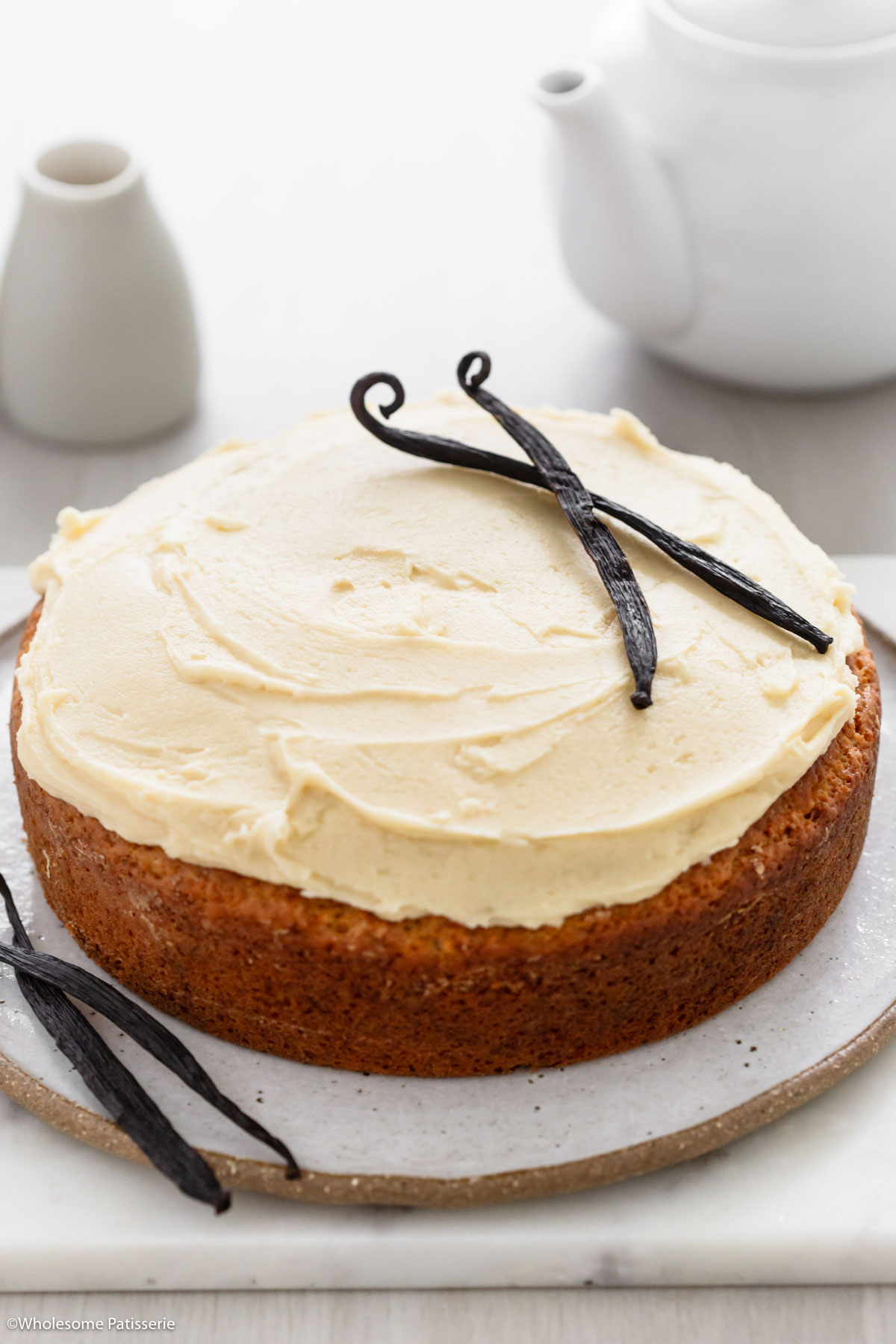
Serving Suggestions
- Ice Cream: Serve it fresh from the oven or slightly warmed with a generous scoop of creamy vanilla ice cream.
- Whipped Cream: Dollop some freshly whipped cream right on top or with individual serves.
- Fresh Berries: A handful of fresh sliced strawberries, blueberries, or raspberries can add a pop of color and a burst of flavor.
- Warm Sauce: How about some warm caramel or chocolate sauce drizzled right before serving?
- Coffee or Tea: For afternoon tea or as a relaxing dessert after dinner, enjoy it with a hot cup of tea, coffee or a homemade hot chocolate.
- Coconut Flakes: For a tropical twist, sprinkle some shredded coconut on top, as seen on my delicious Vegan Vanilla Coconut Cake!

Common Mistakes to Avoid
- Incorrect Pan Size: If you go too big or too small, your cake won’t bake properly. Stick to the recommended tin size, which is a
- Baking Tin Prep: Don’t skimp on greasing and flouring your pan. A stuck cake is a heartbreaker. For added insurance, I always line just the base too.
- Check Expiry Dates: Always double-check the expiry dates, especially for baking soda and powder as these are critical in an eggless cake.
- Oven Temperature: Not all ovens are created equal! Make sure to preheat fully, 30 minutes prior to putting your cake in and consider an oven thermometer if you’re unsure about your oven.
- Overmixing: Mix just until the batter is incorporated and no streaks or lumps of flour remain. Overmix, and you’re signing up for a dense cake.
- Skipping the Toothpick Test: Don’t just rely on bake time. Do the toothpick test to make sure it’s fully baked. The toothpick needs to come out clean.
- Early Frosting: Frosting too soon? Say hello to a melted mess. Patience is key, my friends.
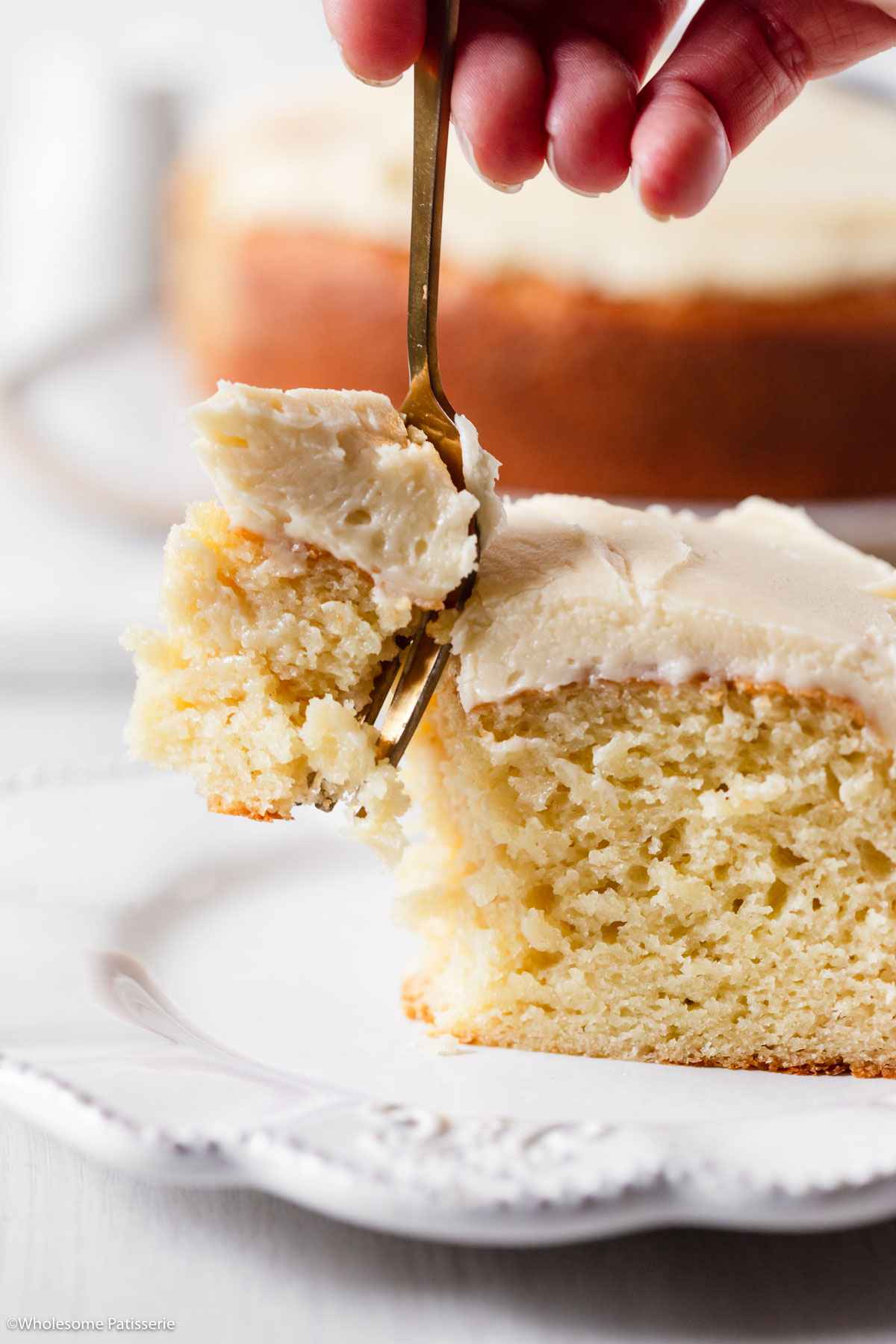
Troubleshooting
Let’s dive into some problems and solutions for you.
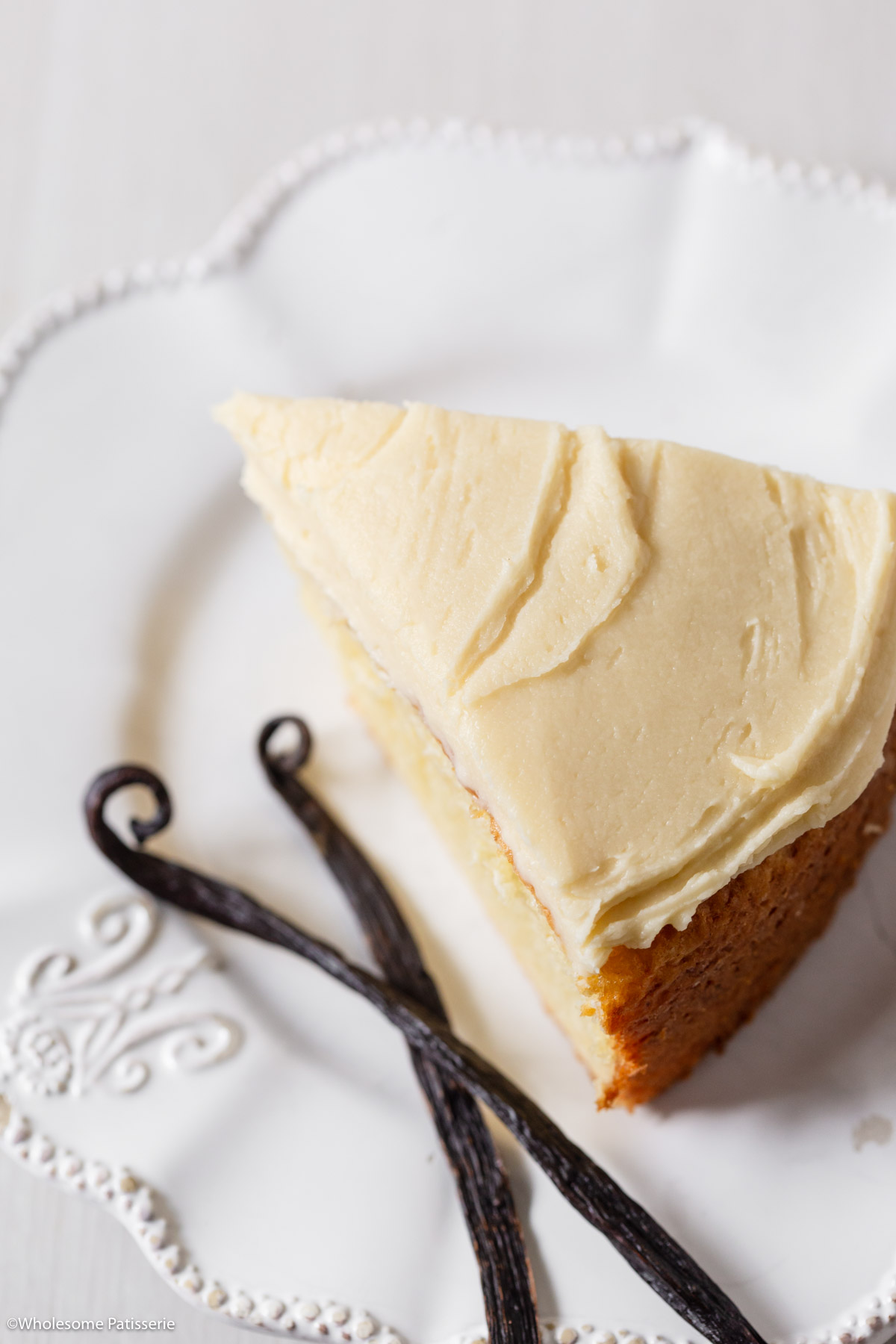
Storage Instructions
Store: Once cooled, store your cake in an airtight container, at room temperature, for 3-4 days. Transfer to the refrigerator after a few days, if needed to keep it fresh and away from humid temperatures.
How To Freeze
- Freeze the cake with or without the frosting, either in individual slices or as a whole cake.
- Wrap the cake/slices tightly in either plastic wrap or a sheet of parchment paper.
- Then, wrap it again in tin foil for added protection.
- Label the wrapped cake with the date of freezing for easy reference.
- Store the cake in the freezer for up to 3 months.
How To Thaw
Once thawed, you can proceed to frost the cake with the buttercream frosting.
Refrigerator Thawing:
This gradual thawing process helps retain the cake’s moisture and texture.
- Remove the wrapped cake from the freezer.
- Place the cake in the refrigerator, keeping it completely wrapped.
- Let the cake thaw slowly for several hours or overnight.
Room Temperature Thawing:
This quick thawing method ensures the cake softens fast.
- Keep the cake wrapped in plastic wrap and tin foil.
- Let it sit at room temperature for a few hours until softened.
- Avoid direct sunlight or heat exposure during thawing.
Partial Thawing for Slicing:
If you froze the entire cake but want only one or a few slices, this process allows you to enjoy individual slices while keeping the rest fresh for later.
- Remove the cake from the freezer and let it sit at room temperature for about 30 minutes to an hour.
- Allow it to partially thaw until it softens enough to be easily sliced.
- Slice the desired portions.
- Refreeze any remaining cake portions you don’t plan to serve immediately.
Recipe FAQ’s
If you enjoy this recipe, please consider leaving a ⭐️ star rating and a comment review below. I love to hear what you think and it’s much appreciated. Thank you! Your email address will not be published. Sam x

Eggless Vanilla Cake
Ingredients
Cake
- 2 cups (300g) all-purpose flour, scoop & leveled
- 1 1/2 tsp baking powder
- 1/2 tsp baking soda
- 1/4 tsp fine salt
- 3/4 cup granulated sugar, golden or white
- 1 cup whole milk, at room temperature
- 3/4 cup plain full-fat Greek yogurt, at room temperature
- 1/4 cup extra virgin olive oil
- 2 tsp apple cider vinegar
- 2 1/2 tsp vanilla extract
Frosting
- 60 g unsalted butter, softened to room temperature
- 2 cups powdered sugar
- 2-3 Tbsp whole milk
- 1 tsp vanilla extract
Instructions
Cake
- Preheat oven to 180ºC (356ºF). Line a round 9-inch baking pan with parchment paper, and set aside. NOTE: Alternatively, if you have a non-stick pan, liberally grease it with melted butter and dust it with a light layer of flour. This will leave your finished cake with smooth sides.
- In a large mixing bowl, add flour, baking powder, baking soda and salt. Whisk until well combined.
- Whisk through sugar.
- Pour in milk, yogurt, oil, vinegar, and vanilla. Gently fold and mix with a rubber spatula until incorporated, about 40 seconds, ensuring not to over-mix, just until it’s incorporated into a smooth batter and no pockets/streaks of flour remain.
- Pour batter into the prepared baking tin. Smoothing out the top.
- Bake for 35-40 minutes, or until a toothpick inserted into the middle comes out clean and it’s golden on top.
- Remove from the oven and allow cake to cool in its tin for 15 minutes.
- Carefully remove from tin and transfer to a wire rack to cool completely.
Frosting
- In a large mixing bowl, using either electric hand beaters or a stand mixer with the paddle attached, add softened butter to the bowl.
- Beat butter for about 10 seconds to break it up and turns creamy.
- Add icing sugar, milk and vanilla. Beat until well combined, creamy and fluffy, about 30 seconds, adding more milk if needed, 1/2 Tbsp at a time. Scrape down the sides as needed.
- Spread frosting over cooled cake. Set aside for the buttercream to set, about 20 minutes.
- Slice into triangles and enjoy!
Notes
- Store: Once cooled, store your cake in an airtight container, at room temperature, for 3-4 days. Transfer to the refrigerator after a few days, if needed to keep it fresh and away from humid temperatures.
- Freeze: By cooling it completely after baking, with or without the frosting. Wrap tightly in plastic wrap and tinfoil, label with the date and store for up to 3 months in the freezer. Please refer to above blog post for detailed storing and freezing instructions.
- Thaw: the frozen cake by choosing either refrigerator thawing (slow, several hours) or room temperature thawing (quick, a few hours). If you froze the cake without the frosting, this is the point when you can make the buttercream and frost the thawed cake.
